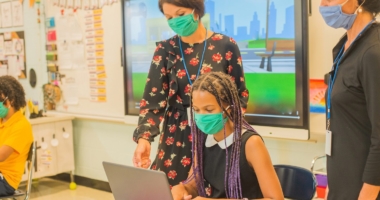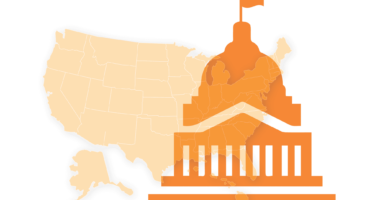5 Things State Leaders Should Do to Ensure the Latest Federal Stimulus Funds for Schools Are Used Equitably
In April 2020, I wrote about how states could ensure that federal stimulus funds issued through the CARES Act could be used to advance educational equity in the face of the direct and immediate strains placed on schools by the COVID-19 pandemic. Nearly nine months later, our country continues to wrestle with the challenges of ongoing at-home learning, the catastrophic and inequitable health and economic impacts of the pandemic, the ongoing fight against racial inequity brought to the steps of the Capitol by domestic terrorists, and a significant federal transition ushering in a new presidential administration and change of majority in the Senate. Unfortunately, these cascading crises have only exacerbated educational inequities, meaning that many of the recommendations from April remain unchanged and equally urgent.
In response to the ongoing coronavirus crisis, the former president signed the Coronavirus Response and Relief Supplemental Appropriations Act (CRRSA) into law on December 27, 2020. The CRRSA provides $81.9 billion to states, school districts, and institutions of higher education through a slightly modified version of the Education Stabilization Fund that was first included in the CARES Act for education purposes. This includes $54.3 billion for K-12, $22.7 billion for higher education, and $4.1 billion for governors to use on K-12 or higher education (though a significant portion of the governors’ funds must be set-aside to support non-public K-12 schools).
Though additional federal funding beyond the CRRSA is still necessary to ensure that all students are supported and the nation’s economic recovery can continue, the CRRSA provides a significant influx of funding that can be used to prioritize the needs of K-12 students who have been disproportionately impacted by this pandemic, including students of color, students from low-income backgrounds, students with disabilities, and English learners, as well as students experiencing homelessness, students in foster care, and students engaged in the juvenile justice system. At nearly three times the level of funding provided last spring by the CARES Act, the CRRSA provides governors and other state policymakers, district leaders, and schools with a tremendous new set of resources that can be used to address the deep and widening opportunity gaps that students and families across the country are facing.
To ensure federal stimulus funds are used equitably, state leaders must:
- Ensure districts distribute funds equitably to schools. The U.S. Department of Education has distributed CRRSA funds to states based on the state’s share of Title I aid. States must then distribute 90% of these funds to districts based on how much the district receives in Title I aid. The law does not require districts to use a specific formula or set of priorities when distributing funding to individual schools. Therefore, the state must ensure districts allocate funds to the schools with greatest needs, including those with the highest numbers of students from low-income backgrounds, students with disabilities, and English learners.
- Ensure school districts have an equity-centered plan to use funding, including to implement evidence-based strategies to accelerate student learning. States have until January 2022 to award funds to school districts and must balance the need to distribute funding quickly with a need to ensure that school districts develop or update plans for how the district will use additional federal funding to meet the continued academic, social-emotional, mental health, and physical needs of all students, and particularly the unique needs of students from low-income backgrounds, students with disabilities, and English learners. These plans should be based on community and parent feedback, aligned with existing district plans (e.g., Title I plans), and lay out a clear plan for how districts will use funding through September 2023, when it expires.A national survey of school leaders revealed that students in high-poverty districts were expected to spend far less time on instructional activities during virtual learning than were their peers in low-poverty districts. Therefore, unlike plans that districts put together in spring 2020, new plans must recognize and address the deep and lasting impacts of interrupted and unfinished instruction. Districts and schools will be responsible for accelerating students’ learning to meet rigorous and challenging standards for months and possibly years to come. This will require targeted actions to accelerate student learning through evidence-based and rigorously implemented strategies, including targeted intensive tutoring (i.e., high-dosage tutoring) and high-quality extended learning time (e.g., in-school programs to increase the amount of instruction, summer programs, afterschool programs). These programs must be informed by evidence (e.g., providing training and ongoing support to tutor, supporting students individually or in very small groups, etc.) so that billions of federal dollars have their intended impact. For more on equity actions, resources, and examples district leaders can take to advance equity, please visit the Alliance for Resource Equity’s Advocate’s Guide to District-Level Equity Actions.
- Use state funding to meet the needs of students who are the most vulnerable. States may reserve up to 10% of the funding they receive — nearly $5.4 billion in total — for state-level activities. That funding should be used to:
- Prepare schools for physical reopening, including through adequate testing and contact tracing, building upgrades to replace ventilation systems, and supplies and support needed to implement basic public health protocols such as masking, distancing, and hand washing
- Provide funding for counselors, social workers, psychologists, and other health professionals, prioritizing districts and schools serving the most students of color and students from low-income backgrounds. In this time of declining revenue, it is particularly important to reallocate resources from school police or similar structures that criminalize students into these more supportive and research-based resources
- Provide COVID-related support (e.g., guidance, ready-to-use toolkits, exemplars) to districts and schools, deliver professional learning and mental health supports for educators as they recover, and work to support students’ academic, social, and emotional recovery from the pandemic. For example, equity-focused state leaders could provide guidance to district and school leaders on developing and cultivating positive, asset-based, and anti-racist mindsets, addressing implicit bias, and developing the skills needed to integrate social-emotional supports into academics
- Continue to bridge the digital divide, particularly in communities of color and low-income communities, by expanding access to technology and technical assistance so that all students can participate in remote and hybrid learning. About 16 million K-12 students as well as 400,000 teachers, still lack access to adequate internet or devices to sustain effective distance learning
- Create or expand existing statewide efforts to accelerate student learning, including through targeted intensive tutoring and extended learning time that prioritizes students who have been most impacted by school closures and remote instruction. Educators will need to administer high-quality assessments to determine where learning must be accelerated.
- Publicly report on — and ensure districts publicly report on — the use of these funds. The state must ensure all local education agencies (LEAs) that receive funds make publicly available how they and schools within their boundaries are spending their allocations, explicitly describing how they will meet the unique needs of individual student groups. The CRRSA requires that states provide a detailed accounting of funds to measure and address unfinished instruction among students disproportionately affected by the coronavirus and school closures, including: students from low-income backgrounds, students of color, students with disabilities, English learners, students experiencing homelessness, and children and youth in foster care. Similarly, states should require that districts report this information both to the state and publicly.In addition, state budget shortfalls may disproportionately affect districts serving large populations of students of color and students from low-income backgrounds, which rely the most on state aid. States should act to avoid this by protecting the most impoverished districts from cuts. However, in districts where funding cuts do occur, staff layoffs are a real possibility, given that teacher salaries and benefits make up more than half of total school spending. States and districts should report on how they are using funds to protect high-need schools from disproportionate staffing cuts and hiring freezes, and states should require districts to collect and publicly report data on any personnel reductions, including the racial and ethnic demographics of those personnel and of the students in the school in which the personnel worked.
- Ensure additional funding is allocated equitably. The CRRSA provides governors with approximately $2.75 billion that must be used to support non-public schools in the state and $1.3 billion that they may use at their discretion for either K-12 or higher education. This flexible funding must be targeted toward school districts and institutions of higher education most significantly impacted by the pandemic. Many Governors used funding from the CARES Act to fund grant programs that expanded access to devices and high-speed internet, but only seven governors targeted funds toward the safe reopening of schools. Beyond stimulus resources, state education agencies (SEAs) should continue to think about how to strategically use their regular funding streams in coming years to close opportunity gaps resulting from school closures and ensure all students ultimately meet grade-level standards by supporting students from low-income backgrounds, students of color, English learners, and students with disabilities who had less access to high-quality educational experiences before this pandemic and whose need for social, emotional, and academic support and services is even more urgent.










